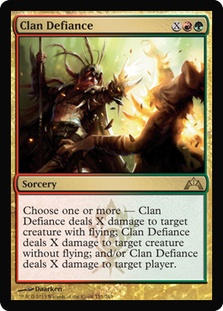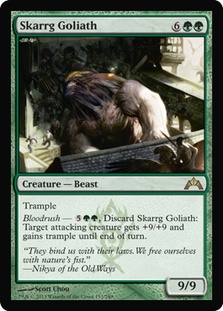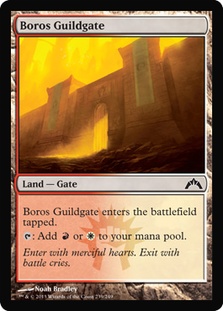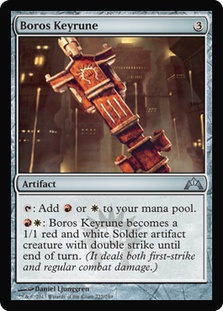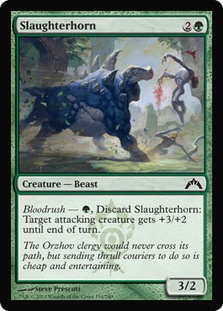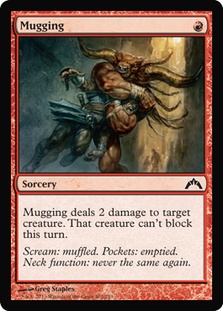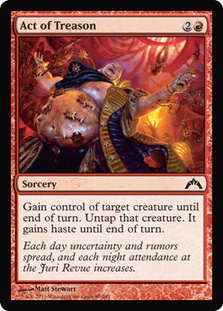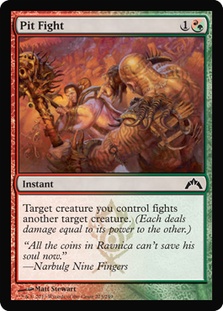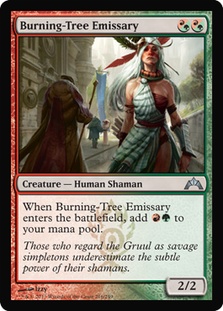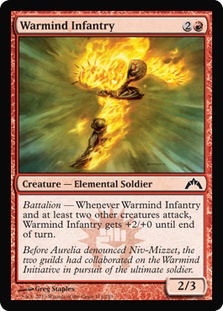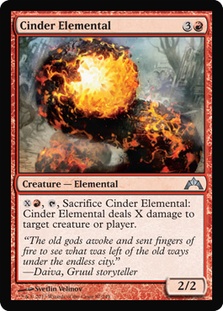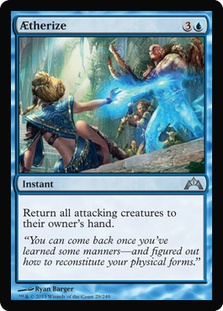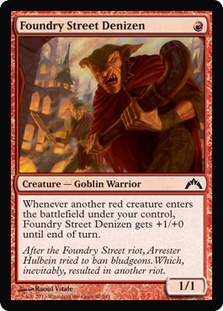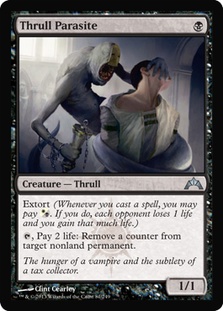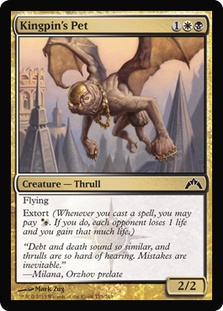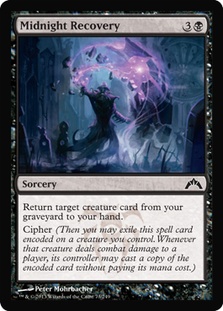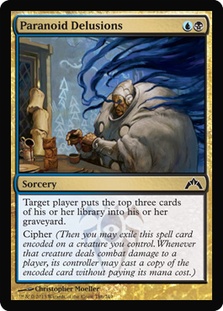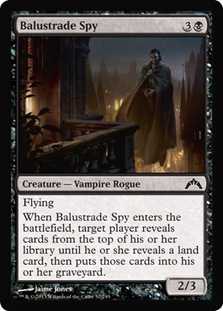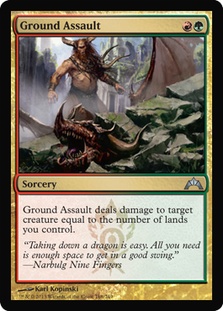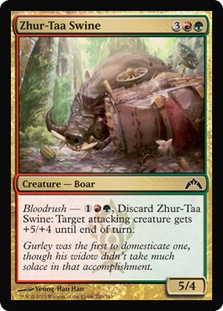Hi everybody! I have recently moved to StarCityGames.com, and I am thrilled to be here. For those of you who have read my previous articles or watched my Draft videos, this will be a pretty seamless transition. For my beloved Twitch audience, I hope you enjoy a little traditional print media. For those of you I am meeting for the first time, I hope you enjoy what you find and let me know if there is anything you’d like to see me do in the future.
A quick little bit about myself. I’m currently a Platinum pro and have been playing on the Pro Tour off and on since 2000. My first PT had an inauspicious start, kicking things off with a draw and then going 0-5 and getting a bye in the last round at PT Chicago in 2000. I was an occasional PT player through the early part of the decade before my “retirement” (can you retire from a non-career?) in 2004.
I had my first real success following my return to the game in 2010, winning an LCQ for PT San Juan and finishing 32nd. I’ve been on the Tour ever since. I am probably best known for my Legacy results, finishing 2nd at GP Columbus in 2010 with a four-color Counterbalance deck and then winning GP Indianapolis in 2012 with Esper Spiritblade. I also picked up a Top 8 at PT Paris with Caw-Blade (the Standard precursor to Esper Spiritblade), two PT Top 16s, and two PT Top 32s since my return. I am a co-founder and co-captain of Team #TeamSCG, where I’ve had the pleasure of working with some of the best and brightest minds on the Pro Tour.
I stream infrequently but have bursts of activity when there are sweet formats on Magic Online and my schedule permits—it is one of my favorite mediums for content because it allows me to interact directly with the audience. You’ll mostly see me here with video content. Please leave comments and questions, since I try to reply to everything that gets posted. Dialogue is one of my favorite aspects of creating videos and articles for you.
Now, on to the business of the day: an actual article!
(Cue scene change.)
Another day, another Prerelease. Gatecrash is finally upon us, and so far I’ve had a lot of fun with the Limited environment. I could see it getting old pretty quickly—how many mechanics do we need that strongly encourage us to send all of our guys into combat in a single set?—but my Prerelease experience was a fun change of pace from Return to Ravnica.
Those of you familiar with my Constructed leanings (*ahem* Lingering Souls *ahem*) might have expected me to go with either third of my favorite Esper shard, but I wanted to see what was up with bloodrush. Selesnya was by far my favorite guild to draft and play with in RTR, largely because of the number of different tricks it had available. Selesnya decks could give opponents fits in the attack step, forcing your opposition to walk a tightrope of instants, each of which could spoil a block or attack in a slightly different way.
Gruul is the natural inheritor of this in Gatecrash. Sure, the vast majority of its tricks can only be used when attacking, but who wants to block anyway? I was curious to see how the mechanic plays out in practice.
First, a quick caveat. These are very raw opinions based on four matches played and maybe half a dozen matches watched. Take the below with a grain of salt, but it might also be interesting to look at how I’m coming to these conclusions with limited information. We all need to confront unknown formats from time to time, and building the skills to prepare you for them is valuable.
My decklist:
Creatures (14)
- 1 Cinder Elemental
- 1 Firemane Avenger
- 1 Rubblehulk
- 1 Burning-Tree Emissary
- 2 Zhur-Taa Swine
- 1 Skarrg Goliath
- 1 Crocanura
- 1 Rubblebelt Raiders
- 3 Slaughterhorn
- 1 Warmind Infantry
- 1 Ruination Wurm
Lands (17)
Spells (9)

This deck was very, very good, and I hope I can get something even close to as good in an upcoming Grand Prix.
The Obvious
Here are a few obvious takeaways.
Prerelease decks are powerful.
With the “guild packs” you are likely to have at least two rares in your Prerelease deck, which is great since it exposes you to some of the more powerful cards right away. It also makes the power level of the Prerelease decks higher than what you can expect at a GP or PTQ.
There are some good rares in this set.
I was fortunate enough to have six rares in my Prerelease deck, and they were all bonkers. By far the best of them were my two copies of Clan Defiance. This card is nutso. It felt like a Bonfire that I didn’t have to miracle.
I also had a Skarrg Goliath. I was worried he would be too slow given how aggressive the set is, but I was pleasantly surprised. I did win several games before I got to seven mana, but twice he went big to bring home a W. The Gruul Prerelease card (the */* for lands with bloodrush of RG1) was solid but not insane; more on him later.
The Insightful
Splashing is doable but dangerous.
There is basically the same fixing that we had in RTR, but with the faster clocks and more aggressive decks, you have less time to durdle around looking for your mana.
I splashed one card in my Gruul deck: Firemane Avenger. I had three “free” white sources in two Boros Guildgates and a Boros Keyrune that I wanted to play regardless to ramp to my larger Gruul monsters and support my two fireballs. Even so, the two times I drew it I didn’t have a white source in play, and the game didn’t go long enough for me to find one. Thankfully, I was able to win both games without needing the Avenger, but I could easily see losing games because of your mid-game mulligan. Splashers beware!
Tempo matters a lot.
Pay attention to how often you are tapping out in this format. There are so many things to do with your mana and a big cost to falling behind, so don’t play Guildgates you don’t really need. This is especially true in Orzhov, where that land could instead be activating an extort. In my Sealed deck, I played three Guildgates (two Boros, one Gruul) and didn’t run into any problems, but I was set up to handle a longer game to capitalize on my two X spells.
Bloodrush is usually the afterthought.
Coming into the Prerelease, I wasn’t sure if most of the bloodrush creatures were pump spells with some upside or creatures with a bonus. Over my eight games, I only activated bloodrush three times. My deck had seven bloodrush guys (three Slaughterhorn, two Zhur-Taa Swine, one Rubblehulk, one Goliath), and the only one I really wanted to use as a pump spell was Slaughterhorn.
There were several spots where I could attack my 3/2 into a 1/4 extort guy and spend my turn Zhur-Taa Swining for the fences to kill it, but each time I was much happier doing anything else (including just passing on my fourth turn) so I could just play the 5/4 later. Anytime you are spending more than one mana to bloodrush, you are going to be hard pressed to also play a second spell in the turn, turning your pump spell into something that is just trading one for one instead of gaining you an advantage in tempo. Think carefully before going down that road.
Extort is the real deal.
In my four rounds, I only played against one Orzhov deck, but he had a great extort chain that could really punish a slow draw or one lacking a breakthrough mechanism. If your deck can’t beat some 1/4s, you could find yourself on the wrong end of a race against the extort drains. If they can start getting you for two or three triggers per turn, you will have a hard time keeping up.
Cheap removal is excellent.
Perhaps this is obvious since removal is always great and cheap removal is at a premium, but I want to emphasize how important it is in some matchups. I had two Mugging in my deck. and they exceeded my expectations. Against Boros, the ability to get out in front of them and break up their battalions before they get rolling is huge.
At one mana, Mugging will let you kill one of their aggressive two toughness guys (such as a Wojek Halberdiers) while still letting you play a cheap drop of your own to get ahead on board. And at least in theory (as I didn’t play against either blue guild), Mugging is going to be great against both Simic, as you can kill their evolvers before they get rolling, and against Dimir, where you really want a cheap answer to cipher.
Battalion was underwhelming.
I think this may have had more to do with the caliber of my deck than the mechanic itself because I was very well positioned to trump them with my cheap guys, two Mugging, and two Bonfire (I mean Clan Defiance), but in my matches it was impossible for my opponent to assemble a functional battalion. By the time he was ready to get going (usually turn 4-5 since I was able to kill off an early creature), I was playing a 5/4 that threatened to eat the weakest link of his team. It is really awkward having to send in three guys to power up one or two of them knowing that at least one of your friends isn’t coming home. Tricks that preserve your battalion members are probably a lot better than they look at first glance.
Thoughts on Specific Cards
Act of Treason
I was pleasantly surprised with how well this card played out. I had two in my deck, and it played very well with my Slaughterhorns, letting me kill my opponents from seemingly high life totals multiple times. It was also great with Pit Fight, though at its best this combo is only a two for two, so it usually isn’t going to be insane.
Pit Fight
I suspect this will turn out to be worse than Prey Upon as the extra mana is pretty brutal. Gruul decks have a significant mana bottleneck since what you’d like to do is bloodrush one of your guys and then Pit Fight him. This is not cheap. Still, fighting is sweet, and your guys do tend to be large. The card was still very good for me.
Burning-Tree Emissary
This card had its moments but was pretty meh, as I expected. If you are playing against Boros, it is great since it is a bear that will sometimes let you play two guys in one turn. Against anything slower, it gets trumped way too fast, so you only want to play it if you really want to be aggressive.
Warmind Infantry
I suspect this guy will be an above-average battalion creature because his three toughness means he can actually survive some combats and his boosted four power means he will almost always at least trade.
Cinder Elemental
This guy is not as good as he used to be. A lot happens quickly, so you don’t really want to spend eight mana over two turns to kill an X/3. That said, he will still always make the cut.
Aetherize
I suspect this will be a critical sideboard card for blue decks against Boros since it is such a huge tempo swing. I am very curious to see how these matches play out in practice.
Foundry Street Denizen
I had several opponents play this against me in their Boros decks to try to get battalion going. I would be shocked if this is viable. He will get picked off the first time you run into resistance, and it is rarely going to be worth a card just to fire off the battalion mechanic for a single turn. (I can also see myself looking back at this in two weeks and shaking my head.)
Addendum: Three Drafts Later
A quick update from the news desk. I now have three more drafts under my belt, and for the most part my opinions haven’t changed yet. I’ve drafted each of Simic, Dimir, and Orzhov once, going 2-1 with each deck. The highlights:
Extort is the real deal. I am pretty sure that any creature with extort is playable and probably borderline good. My extort chain started with the one-drop (Thrull Parasite) and featured as many of the two-mana and three-mana extort guys as I could get my hands on. Kingpin’s Pet is very good and is one of best drops for the deck because it provides a reasonable body to clock them. I think you want to be as aggressive as possible with this archetype and use extort to warp all races in your favor (think of it as a 2/2 or 3/3 lifelink unblockable guy).
One card that has dramatically outperformed my initial expectations is Midnight Recovery. Perhaps it has more to do with the fact that I’ve now played several decks that included mill components, but the card has been very good against me, always bringing back at least two creatures. Playing against it actually led me to start targeting myself with my Balustrade Spy in my Orzhov deck when playing against Swamps because I didn’t want to risk turning it on.
Speaking of milling, I was able to check out its presence in the format with my Dimir attempt. From the spoiler and Prerelease, I had low expectations for the guild, and only opening a Consuming Aberration was able to drag me into it. Unfortunately, I wound up being the third Dimir drafter in a row somehow, but my deck was still perfectly reasonable since I was the only one trying to mill out my opponents. It was actually a pretty good incidental plan; I only had one or two dedicated mill cards (such as Paranoid Delusions). Most of my mill was incidental in the form of Aberration, Sage’s Row Denizen, Mindeye Drake, Balustrade Spy, and Undercity Informer. Informer especially was an all-star. I was really impressed by him. His interaction with Drake was obviously great, and in any kind of board stall I was able to just count their lands and eventually mill them out when they got enough land in play. This isn’t a deck you want to force, but most drafts should have a mill drafter.
My very first draft was also my most straightforward: aggressive Simic splashing some Gruul cards. This deck was all about attacking, which I think will be a common approach to the guild; evolve was very tangential to what I was doing. I had three Drakewing Krasis, which gave me a great means of clocking my opponent. That guy is awesome with bloodrush since one of the big “drawbacks” of bloodrushing in combat is the cost of the activation, which usually takes your whole turn for no gain in tempo. When your creature gets to trample over for the additional damage, you always get to pull further ahead. I splashed four red cards (Ground Assault, Ghor-Clan Rampager, Rubblehulk and Zhur-Taa Swine) off of four red sources (two Stomping Ground, one Gruul Guildgate, one Gruul Keyrune), and it was very worth it. I expect this to be a pretty common pairing.
I will also note that in all of my drafts I’ve still not seen a Boros deck that I really like. The best performance was a 2-1 from a very aggressive deck focused on early battalion. The deck played multiple Foundry Street Denizens to turn on a bunch of the two-drop battalion creatures. It really isn’t where I want to be; you have to play so many (mediocre on their own) creatures that you can’t play a lot of tricks, so most of your turns consist of turning your guys sideways and praying. It seemed pretty easy to trump them in combat and shut down their offense. I’m curious to see if my opinion changes once I’ve had a chance to draft Boros myself.
That’s it for today—I’ll have more thoughts on Gatecrash Limited in the coming weeks once I’ve had a chance to actually do some drafting. Also queued up is a post-mortem on RTR Limited and how you can apply some of the lessons of that format to your Magic game in general, as well as an in-depth look at my current views on Legacy and a deck primer on my latest Esper Spiritblade list. Please post any thoughts or questions in the comments below!

